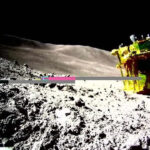Japan’s historic Intelligent Moon Lander (SLIM) is back in operation ten days after making a soft landing on the Moon. Due to a minor glitch during its flawless landing, the lander ended up on its side and was unable to charge its solar panels, forcing it to run solely on batteries. Crucially, the solar panels were facing west at the time, away from the Sun, giving the crew hope that sunlight would eventually reach the panels as the Moon slowly rotated. And yesterday it did just that. SLIM has woken up and even responded with an image.
The team dove headlong into the scientific mission and has already exceeded the expectations of the Japan Aerospace Exploration Agency (JAXA). The goal was a soft, precise landing within 100 meters (330 feet) of a predetermined target area. The intended landing site for Apollo 11, by contrast, was an elliptical measuring 20 by 5 kilometers (12 by 3.1 miles). SLIM appears to have landed precisely 55 meters (180 feet) from its target, a feat never before accomplished on another planet.
Despite the somewhat bumpy landing, SLIM sent out its two small rovers, one of which snapped a picture of the craft tilted on the surface, to explore its surroundings. With power back on and no longer relying on batteries, SLIM is examining the intriguing rocks around the lander with its cameras.
After being named after dog breeds, the six that have been recognized are Toy Poodle, Shiba Inu, Bulldog, Akita Inu, Kai Ken and St Bernard. SLIM has begun a spectroscopic analysis of the Toy Poodle rock, a method that allows the composition of an object to be determined from its light. SLIM will move on to the next rocks when Toy Poodle has been thoroughly examined.
Simultaneously with surface operations, SLIM was also removed from orbit. NASA’s Lunar Reconnaissance Orbiter (LRO) spacecraft flew over the landing site on January 22 and took photographs of SLIM from orbit. At the time, LRO was approximately 50 miles (80 kilometers) above the lunar surface. A side-by-side image shows the 8-foot (2.4-meter) lander along with its rocket impact on the Moon.
Retrorockets kicked up regolith, the top layer of lunar soil that is darker than the underlying layer. It is composed of tiny, irregular, weathered, thin rocks. Moon dust can be hazardous to humans and instruments alike; Apollo 17 astronaut Harrison H. Schmitt was found to have an allergy to the dust.

The regolith uplift was observed near the Indian Vikram lander last summer and even during the Apollo missions; in fact, it was so noticeable during Apollo 11 that Buzz Aldrin said, just before touching down on the Moon, that they were “picking up some dust.”
Now that the Sun has set, SLIM will do everything it can to make up for lost time and complete its science mission before the lander returns to sleep mode in preparation for the frigid 14-day lunar winter.



